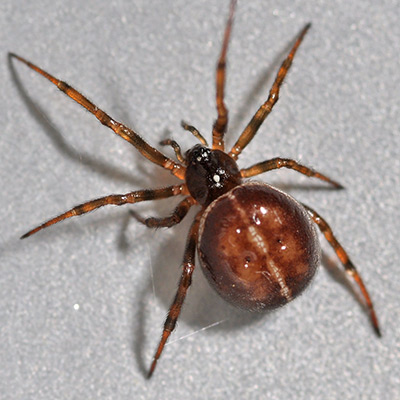
 |
|
Scientific Classifications explained » Amphibians » Ants » Aphids » Bees » Beetles » Birds » Bugs » Butterflies » Caterpillars » Damselflies » Dragonflies » Earwigs » Flies » Frog/Leafhoppers » Fungi » Galls » Grasshoppers » Harvestmen » Hoverflies » Lacewings » Ladybirds » Leaf Mines » Lichens » Mammals » Millipedes » Mosses » Moths » Sawflies » Slugs » Snails » Spiders » Trees » Wasps » Wild Flowers » Woodlice |
UK Nature > Spiders > Steatoda bipuncta

Scientific Name: Steatoda bipuncta Common Name: Rabbit Hutch Spider With a body length of up to 8mm, Steatoda bipuncta is found in many parts of England, but more abundant in southern counties. Females can be seen all year round, but the males are normally only seen from early summer to autumn. This is one of the spiders commonly known as a false widow spider. They're very often referred to as Rabbit Hutch Spiders as this is where they are frequently found. The scientific name 'bipunctata' refers to the two indentations on the abdomen. These False Widows are usually chestnut coloured, although some specimens can be lighter in colour. Frequently there is a line of tiny cream coloured dots running around the midline of the abdomen, and there is sometimes a pale line running along the top of the abdomen from front to back. The males have distinctively large palps. They are usually found around houses, sheds and out-buildings, including rabbit hutches. The web consists of a mish-mash of short, irregularly placed silk strands. When viewed from underneath this species has an unusual marking which looks like the 'Alpha' of the Greek alphabet. |
|

https://www.uknature.co.uk is a website dedicated to showing the immense diversity of UK nature and wildlife. Our vast range of habitats, from lowland arable to snow covered mountains, from storm-ravaged coastlines to peaceful inland freshwater lakes and rivers, from dry, sandy heaths to deciduous and coniferous forests, all these habitats contribute to the abundance of UK nature. We have wild birds in huge numbers either residing or visiting our shores (597 recorded species as at July 2013) and we must also not forget the humble back garden with its grass lawns, flower beds filled with nectar rich flowers, shrubs and trees, all designed to attract huge numbers of insects such as bees, moths, butterflies and hoverflies; and finally the small ponds which provide safe havens for frogs, toads, newts and even slow worms and grass snakes. www.uknature.co.uk is the showcase for my personal passion, photographing uknature in all its glory. I sincerely hope you all enjoy the fruits of my labours. This site and all images contained therein is © Jeremy Lee 2004 - 2021. All Rights Reserved. Site design by Jeremy Lee. Site development & IT Support by Stuart Lee. |